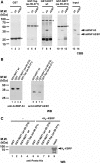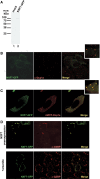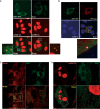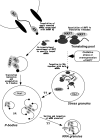Nuclear RNA export factor 7 is localized in processing bodies and neuronal RNA granules through interactions with shuttling hnRNPs
- PMID: 18063567
- PMCID: PMC2241847
- DOI: 10.1093/nar/gkm556
Nuclear RNA export factor 7 is localized in processing bodies and neuronal RNA granules through interactions with shuttling hnRNPs
Abstract
The nuclear RNA export factor (NXF) family proteins have been implicated in various aspects of post-transcriptional gene expression. This study shows that mouse NXF7 exhibits heterologous localization, i.e. NXF7 associates with translating ribosomes, stress granules (SGs) and processing bodies (P-bodies), the latter two of which are believed to be cytoplasmic sites of storage, degradation and/or sorting of mRNAs. By yeast two-hybrid screening, a series of heterogeneous nuclear ribonucleoproteins (hnRNPs) were identified as possible binding partners for NXF7. Among them, hnRNP A3, which is believed to be involved in translational control and/or cytoplasmic localization of certain mRNAs, formed a stable complex with NXF7 in vitro. Although hnRNP A3 was not associated with translating ribosomes, it was co-localized with NXF7 in P-bodies. After exposing to oxidative stress, NXF7 trans-localized to SGs, whereas hnRNP A3 did not. In differentiated neuroblastoma Neuro2a cells, NXF7 was co-localized with hnRNP A3 in cell body and neurites. The amino terminal half of NXF7, which was required for stable complex formation with hnRNP A3, coincided with the region required for localization in both P-bodies and neuronal RNA granules. These findings suggest that NXF7 plays a role in sorting, transport and/or storage of mRNAs through interactions with hnRNP A3.
Figures









Similar articles
-
NXF2 is involved in cytoplasmic mRNA dynamics through interactions with motor proteins.Nucleic Acids Res. 2007;35(8):2513-21. doi: 10.1093/nar/gkm125. Epub 2007 Apr 1. Nucleic Acids Res. 2007. PMID: 17403691 Free PMC article.
-
Extensive association of HuR with hnRNP proteins within immunoselected hnRNP and mRNP complexes.Biochim Biophys Acta. 2010 Apr;1804(4):692-703. doi: 10.1016/j.bbapap.2009.11.007. Epub 2009 Nov 18. Biochim Biophys Acta. 2010. PMID: 19931428
-
Generation and characterization of an Nxf7 knockout mouse to study NXF5 deficiency in a patient with intellectual disability.PLoS One. 2013 May 13;8(5):e64144. doi: 10.1371/journal.pone.0064144. Print 2013. PLoS One. 2013. PMID: 23675524 Free PMC article.
-
Heterogeneous nuclear ribonucleoproteins (hnRNPs) in cellular processes: Focus on hnRNP E1's multifunctional regulatory roles.RNA. 2010 Aug;16(8):1449-62. doi: 10.1261/rna.2254110. Epub 2010 Jun 28. RNA. 2010. PMID: 20584894 Free PMC article. Review.
-
Heterogeneous nuclear ribonucleoprotein A1 in health and neurodegenerative disease: from structural insights to post-transcriptional regulatory roles.Mol Cell Neurosci. 2013 Sep;56:436-46. doi: 10.1016/j.mcn.2012.12.002. Epub 2012 Dec 14. Mol Cell Neurosci. 2013. PMID: 23247072 Review.
Cited by
-
Who Regulates Whom? An Overview of RNA Granules and Viral Infections.Viruses. 2016 Jun 28;8(7):180. doi: 10.3390/v8070180. Viruses. 2016. PMID: 27367717 Free PMC article. Review.
-
FUS regulates RAN translation through modulating the G-quadruplex structure of GGGGCC repeat RNA in C9orf72-linked ALS/FTD.Elife. 2023 Jul 18;12:RP84338. doi: 10.7554/eLife.84338. Elife. 2023. PMID: 37461319 Free PMC article.
-
The Role of Nucleocytoplasmic Transport Defects in Amyotrophic Lateral Sclerosis.Int J Mol Sci. 2021 Nov 10;22(22):12175. doi: 10.3390/ijms222212175. Int J Mol Sci. 2021. PMID: 34830069 Free PMC article. Review.
-
Post-transcriptional trafficking and regulation of neuronal gene expression.Mol Neurobiol. 2012 Feb;45(1):99-108. doi: 10.1007/s12035-011-8222-0. Epub 2011 Dec 14. Mol Neurobiol. 2012. PMID: 22167484 Free PMC article. Review.
-
Complex network-driven view of genomic mechanisms underlying Parkinson's disease: analyses in dorsal motor vagal nucleus, locus coeruleus, and substantia nigra.Biomed Res Int. 2014;2014:543673. doi: 10.1155/2014/543673. Epub 2014 Nov 26. Biomed Res Int. 2014. PMID: 25525598 Free PMC article.
References
-
- Gruter P, Tabernero C, von Kobbe C, Schmitt C, Saavedra C, Bachi A, Wilm M, Felber BK, Izaurralde E. TAP, the human homolog of Mex67p, mediates CTE-dependent RNA export from the nucleus. Mol. Cell. 1998;1:649–659. - PubMed
Publication types
MeSH terms
Substances
LinkOut - more resources
Full Text Sources
Molecular Biology Databases

